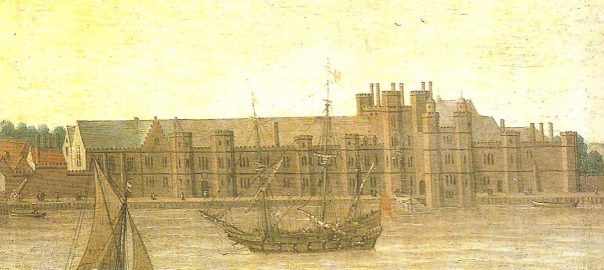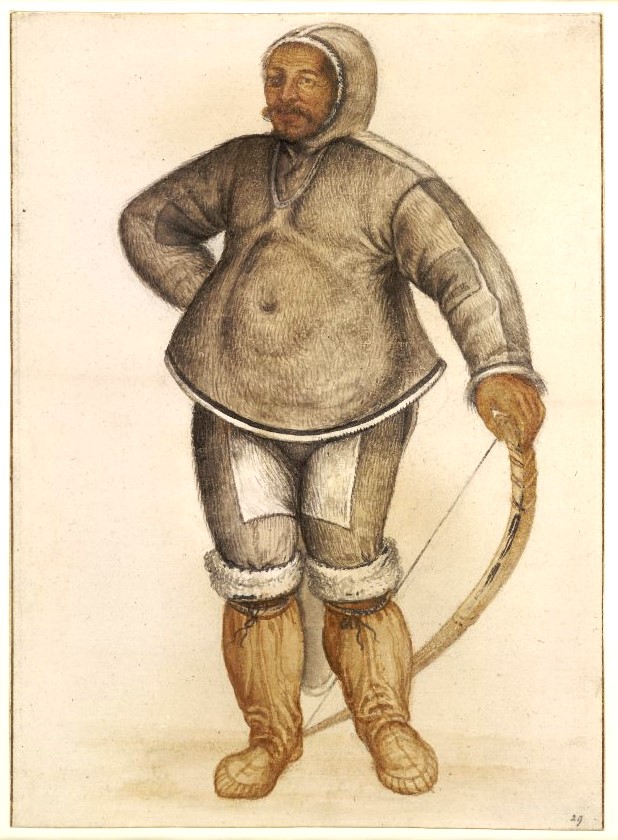The major developments of world-historical importance in 1577 CE stemmed from the decisions England’s Queen Elizabeth I made to support two significant– and, she must have hoped, potentially very profitable– transoceanic “voyages of exploration”.
By this time, Elizabeth had been on the throne for 19 years. She had done well consolidating her rule at home. England had lots of expertise at seafaring. It was certainly abundantly clear to her and all her advisors that the Spanish and Portuguese, who between them had divided up the whole “world” of European trans-oceanic trading, would not welcome another European interloper into that arena. But as she knew, from the earlier voyages made by John Hawkins, Anthony Jenkinson, John Lok, and others, the profits could be massive…
So here we go:
Martin Frobisher
One of the voyages sent out by Elizabeth in 1577 was led by Martin Frobisher, an experienced seaman who had made several significant earlier voyages. In one, the crew set out to plunder Portuguese ships operating along the coast of West Africa, but fell into very bad circumstances there. In another, in 1563, Frobisher and his associates plundered five French ships and a Spanish ship off the south coast of England. Frobisher was imprisoned in connection with that latter expedition but was soon freed. In the years that followed he operated at the fringes of English law, sometimes working with the queen’s “Privy Council”– as when he sailed to the Irish coast to support English efforts to put down an Irish rebellion– and sometimes skirting or outright flouting the law.
In 1576, he had gotten permission and backing from the Privy Council to launch an expedition to find the long-sought “Northwest Passage” to the riches of the Orient–that is, a route around the north coast of North America– and he worked with a London-based investment conglomerate called the Cathay Company, to finance it. That time, he made landfall at Baffin Island, a large island off the northeast coast of today’s Canada/Nunavut, where five of his men were captured by the Inuit, and he appears to have captured one Inuit. He also stole from the shore a large black piece of rock, and when he got back to London he claimed it contained gold.
(The banner image above shows Greenwich Palace in London, from which the queen would wave at departing explorers.)
In 1577, Frobisher fitted out a much bigger expedition. English-WP tells us that, “the Queen lent the 200-ton Royal Navy ship Ayde to the Company of Cathay (Frobisher’s biographer James McDermott says she sold it) and invested £1000 in the expedition.” So Frobisher’s little fleet of the Ayde and two other ships set out from London in May and eventually made landfall on Baffin Island again, where they kidnapped three Inuit: “a man called Calichough, a woman, Egnock, and her child, Nutioc. All three died soon after their arrival in England…. “
Frobisher also stole some more minerals from the shore– enough to persuade the Queen to back another, larger expedition the following year. On his 1578 expedition, an even larger, Frobisher-led fleet brought back even more minerals: “The ore was taken to a specially constructed smelting plant at Powder Mill Lane in Dartford; assiduous efforts to extract gold and further assays were made over five years, but the ore proved to be a valueless rock known as hornblende and was eventually salvaged for road metalling and wall construction. The Cathay Company went bankrupt… “
Spoiler alert: We’ll hear more of the exploits of this practised grifter in years to come…
Francis Drake
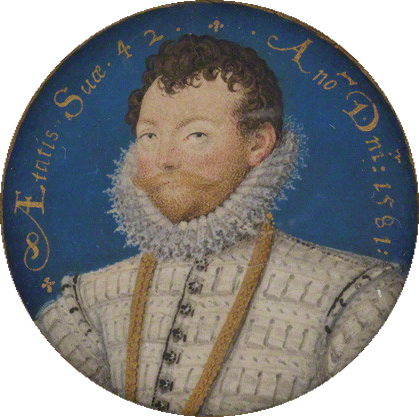
Like Frobisher, Francis Drake was a seafarer who for many years operated at the fringes of the English law. The basic deal in those years was that a European monarch could give a private seafarer a “letter of marque” that gave him permission to raid the ships of other nations and keep the booty in return for a percentage that the issuing monarch would demand. Those guys were called “privateers.” But if you did the raiding without the letter of marque, or if you did any other cargo-raiding of which the monarch disapproved, you’d be called– and hunted and punished as– a “pirate.”
Drake started out running regular commercial cargoes around the North Sea. But in 1563-64, he took his first trip to West Africa on a ship owned by his cousin John Hawkins. Then, three years later, he was on a Hawkins-backed slavetrading voyage: “They attacked Portuguese towns and ships on the coast of West Africa and then sailed to the Americas and sold the captured cargoes of slaves to Spanish plantations. The voyage was largely unsuccessful and more than 90 slaves were released without payment.” His next slaving voyage, made alongside John Hawkins, ended in the ill-fated 1568 incident at San Juan de Ulúa, from which Drake was lucky to escape alive.
Over the years that followed, he had lots of other adventures, including a semi-successful 1573 raid in Panama on the Spanish “Silver Train”, the train of mules that the Spanish conquistadors of Central America would use once or twice a year to get the products of their silver mines in Peru over the isthmus of Panama, to be put onto ships on the Caribbean coast that would haul it off to Spain.
In 1575, Drake commanded boats in the Irish Sea whose purpose was to support the Rathlin Island Massacre, an incident in which the English laid siege to a castle at Rathlin that was held by Irish rebels. Though the rebels surrendered, the English troops “killed all the 200 defenders and more than 400 civilian men, women and children of Clan MacDonnell.”
… So in 1577, Elizabeth gave Drake a “patent” to take a fleet of six ships (one of them previously captured, along with its very expert navigator, from the Portuguese), with the mission of rounding Cape Horn and exploring the West coast of the Americas. He set sail from Plymouth aboard his main ship, the Golden Hind, in mid-December 1577, on an incident-packed voyage that over the three years that followed would establish him as the first English captain to circumnavigate the world on a single voyage.
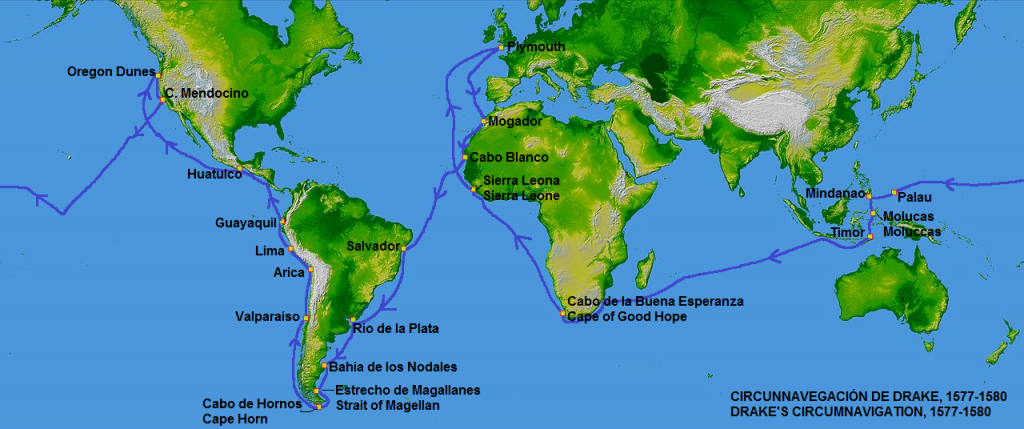
Along the way, Drake would indeed round Cape Horn and sail up the Pacific coast of the Americas as far as the Oregon Dunes (including a stop in Northern California)… and then across the Pacific to the Moluccas, Timor, around the Cape of Good Hope and then back up the West Coast of Africa to Plymouth. And along the way, he would capture at least two well-loaded Spanish treasure ships.
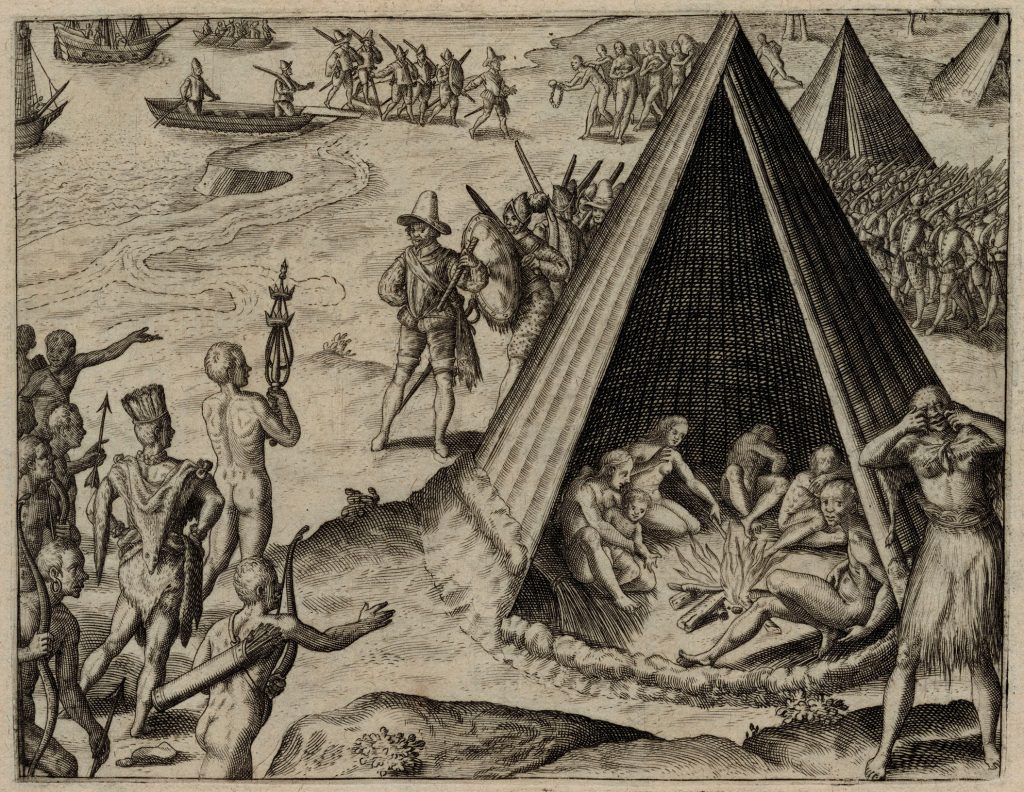
English-WP:
On 26 September [1580], Golden Hind sailed into Plymouth with Drake and 59 remaining crew aboard, along with a rich cargo of spices and captured Spanish treasures. The Queen’s half-share of the cargo surpassed the rest of the crown’s income for that entire year. Drake was hailed as the first Englishman to circumnavigate the Earth (and the second such voyage arriving with at least one ship intact, after Elcano’s in 1520).
The Queen declared that all written accounts of Drake’s voyages were to become the Queen’s secrets of the Realm, and Drake and the other participants of his voyages on the pain of death sworn to their secrecy; she intended to keep Drake’s activities away from the eyes of rival Spain. Drake presented the Queen with a jewel token commemorating the circumnavigation. Taken as a prize off the Pacific coast of Mexico, it was made of enamelled gold and bore an African diamond and a ship with an ebony hull. For her part, the Queen gave Drake a jewel with her portrait, an unusual gift to bestow upon a commoner…
We will definitely hear more of Drake in the years to come.
